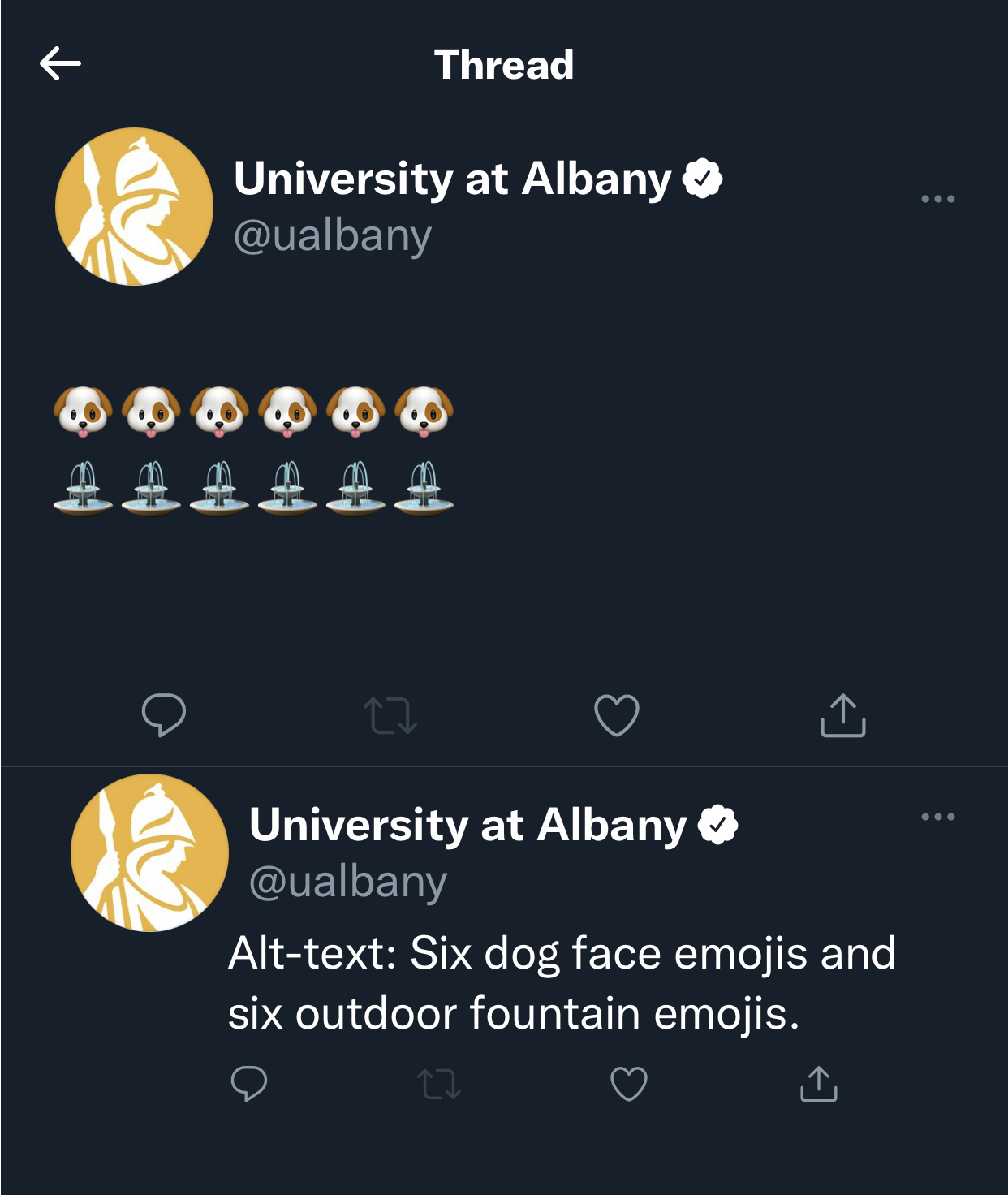Overview
The University at Albany and its many offices, programs and organizations use social media to make meaningful connections. Our main institutional social media accounts are managed by the Office of Communications and Marketing (OCM) but other accounts belonging to individual units across campus are managed by those units.
Links to content or other websites should not be construed as an endorsement of the organizations, entities, views or content contained therein. The University is not responsible for the content of those external web sites.
For more information, please review the University's Social Media Use and Accounts Policy.
OCM regularly reviews content shared with or on its social media pages. We appreciate your comments, posts, messages and responses, and we encourage your questions and constructive feedback.
To create and maintain a quality environment for everyone, we request that participants post content and commentary that is relevant and respectful to our online community. Specifically, please refrain from posting content including:
- Profane, libelous, slanderous or otherwise inappropriate language
- Racist, sexist, obscene and/or abusive content
- Spam (advertisements, etc.)
- Promotions not related to or affiliated with the University at Albany
- Comments not relevant to the conversation topic
By submitting content to any of the University's social media sites, users understand and acknowledge that this information is available to the public, and that the University may use this information for internal and external promotional purposes. Please note that other participants may use posted information beyond the control of UAlbany. Users who do not wish to have information they have made available via these sites used, published, copied and/or reprinted should not post on social media sites.
Social Media Guidelines
These guidelines are intended to help University at Albany staff, faculty and students create social media content that creates and nurtures relationships, shares information, advances knowledge, raises awareness, builds support, participates in important conversations and collaborates on new ideas.
It's a conversation. “Talk” on social media like you would talk to real people in professional situations. Avoid overly "composed" language. Consider content that's open-ended and invites interaction. Encourage comments.
Say something of value. Posts should be thought provoking and build a sense of community. If it helps raise awareness of the University and its entities, solves problems or improves skills, then it's adding value.
Be accurate. Make sure you have accurate facts before posting. It's always better to first verify information with a source than to have to post a correction or retraction later. Cite and link to your sources whenever possible. If you make an error, correct it quickly and visibly. Mistakes happen, you’re human. Be upfront and quick with your correction.
Use our official name. Our only official names are “University at Albany” and “UAlbany.” Please be sure to use one of our official names in all communications including usernames, bios, hashtags, logos, posts, etc. You may also use "Great Danes," "Great Dane" and "Damien the Great Dane." (Never use UA, SUNY Albany, University of Albany, Danes, Lady Danes, Damien.
Link back. You are encouraged to provide links back to albany.edu.
What you write is your responsibility. Participation in University social media channels is not a right but a privilege and opportunity. Therefore, be respectful. Refrain from using profane, libelous and slanderous language, and do not post inappropriate comments.
Be respectful. Some negative comments do not require a response, while others should be taken seriously and addressed. While discussing a negative experience or disagreeing with a concept or person, you are more likely to achieve your goals if you are constructive and polite.
Protect confidentiality. Do not post confidential or proprietary information about the University, faculty, staff or student. Never comment on anything related to legal matters, litigation, or any parties in litigation with the University.
Social media sites are public. There's no such thing as a "private" social media site. Search engines can turn up posts years after the publication date. Comments can be forwarded or copied. Archival systems save information even if you delete a post. You are legally liable for what you post on your site and on the sites of others. Be sure that what you post today will not negatively affect you in the future.
No product endorsements. Do not use the University at Albany’s name to promote products, causes, political parties or candidates.
Be aware of the rules on each platform. Each social media platform has its own guidelines, rules and regulations. For example, Facebook has very specific rules for contests and giveaways. Please be aware of the rules and guidelines in the platform you are using.
Social Media Accessibility
UAlbany adheres to SUNY’s Electronic and Information Technology (EIT) Accessibility Policy, which recognizes SUNY institutions’ responsibility to assure that individuals with disabilities and individuals who are temporarily disabled have equitable access to electronic information resources, which includes University social media.
These guidelines are intended to help University at Albany staff, faculty and students create social media content that is accessible to people with disabilities.
Each social media platform has different accessibility features and limitations. Check with each individual platform to review their accessibility resources and most up-to-date capabilities. The following topics are universal across all platforms.
Alternative text (also known as alt text, alt tags and alt descriptions) is a written image description that helps screen reading tools describe images to visually impaired readers. It also appears in place of an image on a webpage if the image fails to load. Alt text descriptions are read aloud through a screen reader to visually impaired readers.
Best practices for alternative text
- Describe the image itself.
- Be succinct.
- Use dashes for acronyms. For example, you might write “LC” as “L-C” so the screen reader doesn’t pronounce it as “lc”
- Avoid redundancy. No need to include “Image of…” in the description since the alt text implies that information.
- End the alt text with a period. It causes screen readers to pause slightly, making for an easier reading experience.
For example:
For all video content, you must provide captions of the audio for those who are hard-of-hearing, or non-native speakers. There are two types of captions: closed captions (where a user can enable or disable the captions) or open captions (where the text is embedded or burned into the video and cannot be turned on or off).
Do not rely on auto-captioning if it is offered by a platform. Auto-captioning typically contains several grammatical and spelling errors. If you do use auto-captioning, be sure to review and edit as necessary before publishing.
Review the social media platform’s accessibility support features to determine which captioning type is needed. A general rule of thumb is if you cannot upload a .srt file with your video, you should use open captions and burn the captions into your video.
Screen readers will describe emojis included in social media posts. The 👍 emoji will be read aloud as “thumbs up.”
Do not use symbols to create an emoji or emoticon. For example, “:-)” would be read aloud by a screen reader as “colon dash right parenthesis.”
Do not use emojis in place of words (especially words that convey important information) and do not use emojis in the middle of a sentence. Consider the experience for screen reader users. For example:
We recommend you use emojis sparingly. If you're using several emojis at once, add alt text to your social media post. For example:
Hashtags are an important component of social media posts.
When creating and using hashtags that are made up of multiple words, use CamelCase. CamelCase, also known as initial capitalization or initial caps, means capitalizing the first letter of multiple words in a hashtag, which makes the hashtag appear to have humps (like a camel’s back).
Utilizing this simple technique makes the hashtag easier to read for all users and is more consumable by screen readers since their synthesized voices can recognize and pronounce individual words.
For Example: #OneOfTheGreats is in CamelCase and is easier to read than #oneofthegreats.





